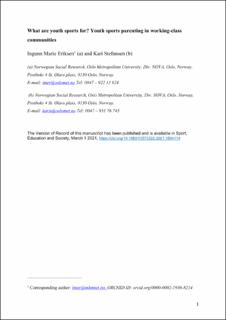What are youth sports for? Youth sports parenting in working-class communities
Peer reviewed, Journal article
Accepted version
Permanent lenke
https://hdl.handle.net/11250/2771770Utgivelsesdato
2021Metadata
Vis full innførselSamlinger
Originalversjon
10.1080/13573322.2021.1894114Sammendrag
This paper explores youth sports parenting in the context of Norway, focusing on the orientations of parents living in predominantly working-class communities, specifically what they believe youth sports are for. Its particular focus is the ideas and resources that underpin the various positions parents in such communities take toward youth sports. Drawing on qualitative interviews with 19 parents of 13 and 14 year olds, we identify two orientations towards youth sports: the belonging orientation, in which youth sports are seen as a means of connecting to a community, and the structuring orientation, in which youth sports are primarily used for protection and to provide frames for children, particularly as a bulwark against excessive screen time and sedentary and unhealthy lifestyles. Despite their differences, both orientations may be seen as articulations of a shared parenting ethos of ‘fitting in’ instead of ‘standing out’, which is aimed at ensuring that children will become decent and able citizens with sound, respectable lifestyles. This parenting ethos differs from the investment and cultivational ethos that guides upper middle-class families’ parenting practices related to sports and other enrichment activities. However, fitting in does not preclude projects of distinction; for some community-oriented parents, engaging in youth sports allows them to stand out as pillars of society.
